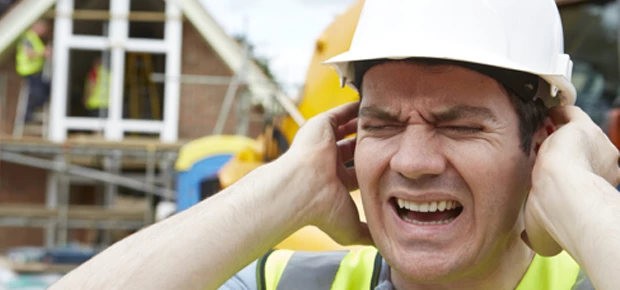
How to prevent noise-induced hearing loss in your facilities
In the U.K., no other disability prompts more civil claims than industrial hearing loss. In fact, hearing loss accounts for three out of four occupational disease claims. Both businesses and employees have a responsibility to protect themselves from noise-induced hearing loss. Follow some common sense guidelines to eliminate noise-related hearing damage in your facilities and on the job site.
Measure the Noise
If you haven’t already, ask a qualified professional to assess the noise levels in your buildings. Don’t skimp on this assessment by trying to do it yourself. Under the 2005 Control of Noise at Work regulations, failing to have conditions assessed by a qualified professional can expose you to liability.
The assessment should contain an estimate of how your facility or job site noise levels compare to exposure limits and action values. It should also provide direction for protecting your workers, and it should identify specific workers who might require ongoing health surveillance. If your workers experience sound above exposure limit values, which equal a daily or weekly exposure of 87 decibels or a peak sound pressure of 140 decibels, you should take immediate action to reduce their exposure to damaging sound levels. Start providing hearing protection immediately, and review ways that you can cut sound levels quickly. If you don’t meet these guidelines, your employees have the right to seek personal injury representation.
If the assessment doesn’t find immediate danger, you’re still obligated to distribute information to employees about hearing protection at work. Also, since certain zones of your buildings or job sites might produce more noise than others, mark any areas in which your workers would need to wear hearing protection.
As an employer, you also have to provide these health surveillance services:
- Regular hearing checks. Check employee hearing annually for the first two years of the program and also for the first two years of employment. Thereafter, you can start checking every three years.
- Sharing hearing checks results with employees. Trained personnel should conduct all of your hearing checks, and employees should always have access to their records.
- Keeping employee health records. A doctor or nurse with the right training or experience should oversee your health surveillance program, and you should keep records on-site in addition to any records your overseer might maintain.
- Helping employees see a doctor if they have hearing damage. Ask your health surveillance overseer to refer your employees to a doctor if needed.
Rethinking Your Equipment
Before you purchase new equipment for your facilities, check the manufacturer’s documentation for information on noise levels. When possible, try to keep noisy machines in locations where workers don’t go. If the machine has to stay in the work area, take some added precautions to reduce its noise impact. HSE offers the following suggestions:
- Rotate workers into and out of the area. Don’t require workers to do complete shifts in a high-noise area. Instead, staff your plant so that you’re rotating employees in and out of high-decibel work areas, and make sure they wear hearing protection.
- Enclose the machine. Purchase a sound-insulating enclosure for your machine, and add anti-vibration mountings if needed. If you can’t enclose your machine, surround it with acoustic screens, and add a silencer to the exhaust system if needed.
- Add linings. For machines with hoppers, you can add lining to limit noise that occurs when material impacts against the hopper. For all machines, you can line panels and guards with noise dampeners.
- Maintain your equipment. Keep your equipment in good repair so that noise stays to a minimum. Sometimes, just fixing a rattling component can significant cut the machine’s decibel level.
Employee Responsibilities
You’re not the only one who’s obligated to prevent noise-induced hearing loss at work. Your employees have to be part of the solution. When you provide hearing protection, let your employees know that wearing it is mandatory. If your workers refuse to wear hearing protection or refuse to report for hearing checks, make sure you document their lack of cooperation. Also, if you set up an appointment for a hearing check follow-up and your employee doesn’t attend, make a note of it in the employee’s file.
By following the Control of Noise at Work regulations carefully and documenting your activities, you’ll protect your business from noise-induced hearing loss claims. You’ll also ensure a long working relationship with your employees.
This was posted in Bdaily's Members' News section by Megan Andrews .
Enjoy the read? Get Bdaily delivered.
Sign up to receive our popular morning National email for free.








 When will our regional economy grow?
When will our regional economy grow?
 Creating a thriving North East construction sector
Creating a thriving North East construction sector
 Why investors are still backing the North East
Why investors are still backing the North East
 Time to stop risking Britain’s family businesses
Time to stop risking Britain’s family businesses
 A year of growth, collaboration and impact
A year of growth, collaboration and impact
 2000 reasons for North East business positivity
2000 reasons for North East business positivity
 How to make your growth strategy deliver in 2026
How to make your growth strategy deliver in 2026
 Powering a new wave of regional screen indies
Powering a new wave of regional screen indies
 A new year and a new outlook for property scene
A new year and a new outlook for property scene
 Zero per cent - but maximum brand exposure
Zero per cent - but maximum brand exposure
 We don’t talk about money stress enough
We don’t talk about money stress enough
 A year of resilience, growth and collaboration
A year of resilience, growth and collaboration